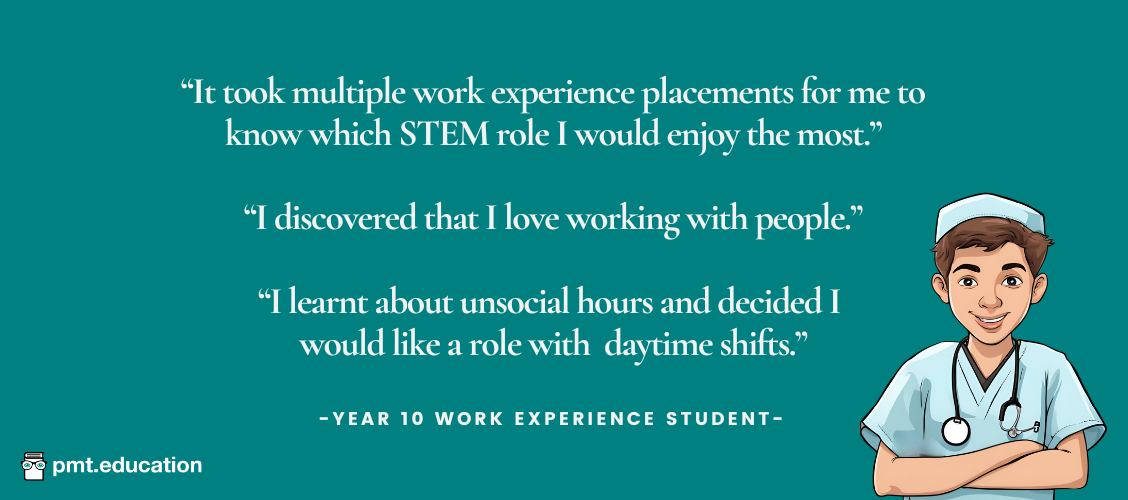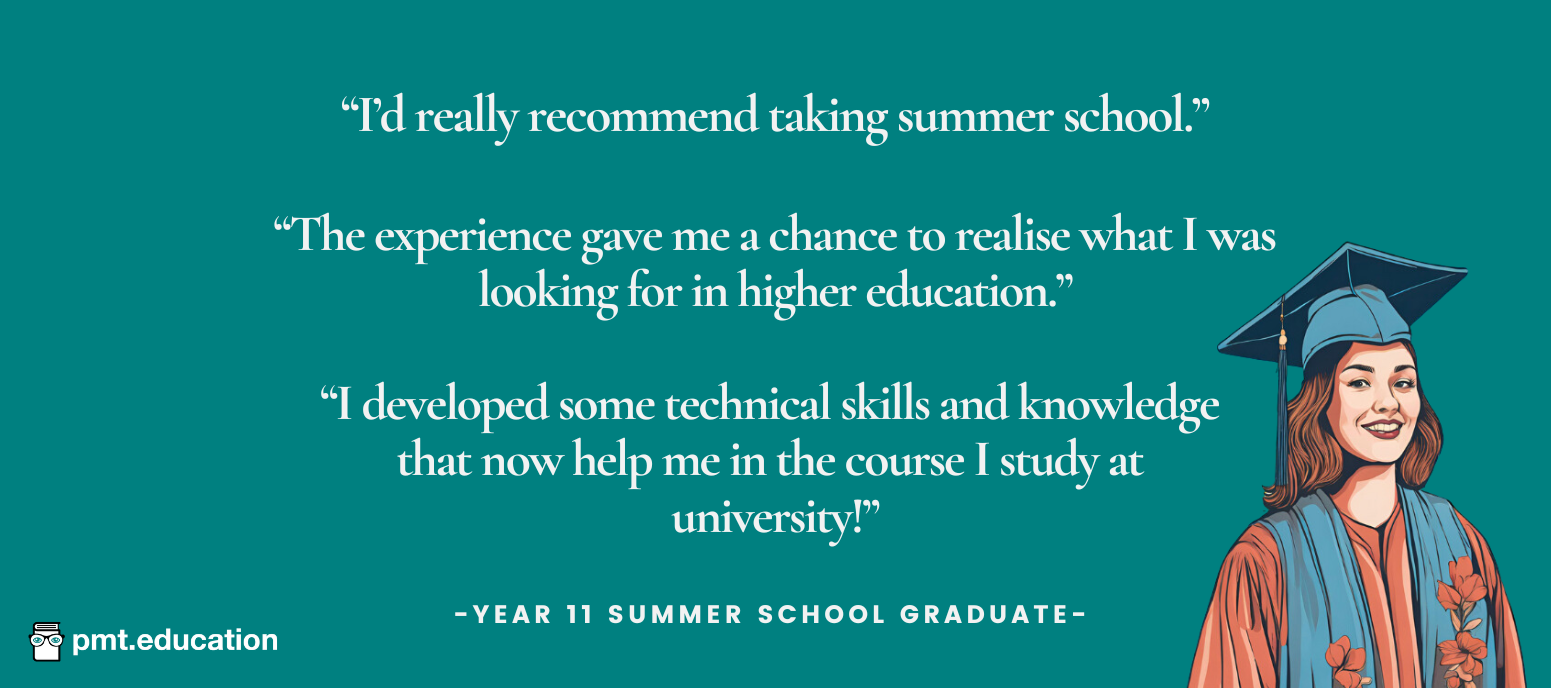Contents:
What are extracurricular STEM activities?
If you enjoy STEM at school and want to see its real-world applications, getting involved in extracurricular STEM activities is a great next step. These activities go beyond classroom learning, offering hands-on experience, helping you explore potential career paths, and connecting you with like-minded individuals. Extracurricular STEM activities encompass anything that reveals how STEM functions in the real world.
In this article, we dive into five popular extracurricular options for STEM enthusiasts: awards, work experience, volunteering, mentorship, and summer schools. To learn more about why participating in these activities is valuable, check out our article on the importance of studying STEM outside the classroom.
STEM Activity 1: Competitions and awards
What are STEM competitions and awards?
STEM competitions are challenges that encourage students to put their academic knowledge to use in a practical, competitive environment. Students are often awarded both for participation and success. STEM awards are projects that give students certified recognition for skills that are often overlooked by academic qualifications. Both competitions and awards can be used to evidence skills in your CV. They also highlight to future employers the important qualities of perseverance and commitment to finishing projects.

What STEM competitions and awards are available?
STEM competitions and awards take many different forms and are run by a multitude of providers, ensuring there are opportunities to suit everybody’s interests. Below we have listed some popular STEM awards and competitions.
1. CREST Awards
A scheme which awards students for conducting a STEM research project outside of school. The project requires you to:
- Choose a STEM topic to investigate
- Plan your project (a practical experiment, design brief, research piece, or scientific communication strategy).
- Collect evidence
- Provide an analysis and evaluation
- Deduce a conclusion
Students who impress could receive a bronze, silver, or gold STEM award.
2. The Big Bang Fair
A competition hosted at the UK’s largest STEM celebration, open to students aged 11-19. The competition requires you to:
- Submit a project you have completed in any STEM field
- Present your project at the fair through a written report, oral presentation, or visual display
All students will receive a certificate of participation, while outstanding students may be awarded trophies. Additional benefits may include educational scholarships, work experience, and mentorship opportunities.
3. RSB competitions
A variety of competitions and awards for students with an artistic flare and an interest in biology.
Two notable competitions include:
- The photography competition with a focus on biological themes
- The BioArtAttack 2D competition where drawers and painters depict their favourite animal, plant, or fungi.
Winners are selected in various categories and receive prizes for their creation.

4. CanSat
A small-scale space project competition for students aged 14+ interested in space, aerospace engineering, and scientific technology. The competition requires you to:
- Work in a team to carry out scientific research and construct a satellite
- Launch your satellite
Students compete to win prestigious certificates for various elements of the project.
5. NYAS’ Junior Academy
A scheme run by the New York Academy of Sciences, which combines STEM competitions with mentorship and networking. The scheme requires you to:
- Apply in April with a statement of interest
- Submit innovation projects for evaluation by experts
- Communicate with STEM students across the globe
- Attend workshops and webinars
Students receive a certification of attendance and may be recognised for outstanding work.
6. Youth STEMM Award (YSA)
An award for the completion of STEMM extracurricular activities for any STEMM student (including medicine).
The scheme requires you to log hours spent on STEMM-related activities. This could include:
- Projects, awards, and competitions
- Work experience
- Educational trips and after school clubs
The more hours logged, the higher the STEMM award received.
Top tips for STEM competitions and awards
- Choose wisely: Choose competitions that align with your interests and strengths.
- Plan ahead: Start your project early to allow ample time for research.
- Seek feedback: Ask others for advice and incorporate their suggestions.
- Get stuck in: The effort you invest will affect the benefits you gain, so give it your best effort.
- Be realistic: Balance your project work with academic commitments to avoid overwhelming yourself.
If you are looking for more STEM competitions and awards, Neon Futures and STEM Learning are excellent resources. Neon Futures offers a local database for engineering and technology events, providing guidance, success tips, and professional insights. STEM Learning features a range of competitions including those in space, LEGO, animation, robotics, and engineering, collaborating with the UK government and educational institutions to showcase opportunities.
STEM Activity 2: Work experience
What is STEM work experience?
STEM work experience is any scenario in which you learn about a job within STEM by spending time with an employer. This might include job shadowing (following a professional and watching what they do as part of their job) or hands-on work. Although usually unpaid, the insights and skills you gain are invaluable.

How can you find STEM work experience opportunities?
There are two main routes to finding work experience:
- Apply to advertised opportunities: Start by exploring the structured work experience programmes offered by many large companies. This can be done by searching online, checking school bulletins, attending careers fairs, and creating a profile on LinkedIn. Keep in mind that these opportunities may arise at different times throughout the year, so it’s important to regularly check for updates.
- Approach companies speculatively: Identify companies that interest you and contact them directly. Ensure you have a well-prepared CV and a compelling cover letter that highlights your skills and interests. This proactive strategy can help you uncover opportunities that are not widely advertised.
How do you approach organisations about STEM work experience?
Making sure you get the most out of work experience begins even before you apply. To ensure the experience aligns with your goals, there are several factors to consider. Use this checklist to ensure you’ve covered all the essentials:
STEM work experience checklist: Things to do before applying
- Research and identify your STEM interests: Explore potential careers by using our STEM careers guides and other resources such as the National Careers Service. Make a list of companies that align with your interests to focus your efforts on opportunities that truly excite you.
- Consider what you would like to gain from the opportunity: Clearly state what you hope to gain from the experience. This helps you convey your objectives and ensures that the opportunity aligns with your personal and professional goals.
- Question what type of experience will help you find out most about the role: Determine which types of experiences will provide the most insight into your desired role. Options include voluntary unpaid work, paid internships, career fairs, career taster sessions, workplace open days, virtual events, and part-time work.
- Prepare your application: Make sure your CV and cover letter highlight your relevant skills and experiences. It’s beneficial to have a senior or mentor review your application to provide feedback.
- Contact companies: Reach out to the HR departments of your target companies using the appropriate method. This can include emails, phone calls, or through their official application portals. Ensure your communication is professional and concise.
What existing STEM work experience opportunities are there?
If you don’t have a particular employee you wish to reach out to and are looking to apply to pre-established, advertised opportunities, then these are some programmes to begin your search with:
- Nuffield Research Placements: 4-6 week supervised research placements for UK-based Year 12 students in various STEM fields. Eligible students may receive a £200 bursary and travel reimbursement.
- In2scienceUK: Online research modules, careers workshops, mentoring, and in-person work shadowing with leading scientists, engineers, and researchers for Year 12 students.
- Empiric’s Next Tech Girls: Work experience in tech for Year 10 and 11 students, partnering with companies like Vodafone and Expedia.
- Operation Wallacea: Biodiversity and conservation management research across Europe and North America.
- Virtual work experience: Virtual placements, providing global access to work experience opportunities.
- University of Nottingham: Veterinary work experience
- Springpod: Hear from professionals and complete activities related to technology careers
- Side Quest: Construction and engineering virtual reality work experience
- Barclays LifeSkills: A day at a digital transformation agency
- Accenture’s Skills to Succeed Academy: STEM employability training
Top tips for STEM work experience
- Ask questions: Learn from colleagues about their career paths and job roles.
- Network: Build connections with professionals and other work experience students.
- Be proactive: Take on various tasks and demonstrate your enthusiasm.
- Stay engaged: Even with mundane tasks, observe and learn about the workplace.
- Showcase your experience: In applications and interviews, concisely and explicitly state what your role was, what you achieved during the experience, the skills and knowledge you gained, and how it supported your interest in that STEM field.
Rejections are a natural part of the process. Learn from the experience, request feedback, and try again. Try to remember that for every rejection you are one application closer to an acceptance! Equally, if your work experience is not what you had hoped it would be, you have still succeeded; the purpose is to decipher what STEM career suits you… often this is by process of elimination!

STEM Activity 3: Mentorship Programmes
What are STEM mentorship programmes?
STEM mentorship programmes connect students with professionals who offer guidance, advice, and support in exploring STEM careers. These programmes help you dive deeper into specific roles or discover lesser-known STEM positions. Typically consisting of one-to-one sessions over an extended period, this personalised mentorship aims to inspire, motivate, and boost your confidence in pursuing the role best suited to you.
How to find a STEM mentor
Similarly to work experience, the two main routes to finding a STEM mentor are to apply to advertised mentorship programmes or to approach mentors speculatively. Mentors can be found through:
- Local universities and colleges: Check the outreach programmes or schools section on local institutions’ websites
- Oxford mentorship programme for Year 12 STEM students
- Imperial College London STEM mentoring and tutoring programmes
- London School of Economics and Political Science student mentor schemes
- School enrichment programmes: Take advantage of any opportunities your school offers and enquire about these if you are not aware of any
- Careers advisors: Ask a teacher or careers advisor for help with searching for mentorship
How do you approach individuals about STEM mentoring?
There’s lots to consider when approaching someone for mentoring. Follow this checklist to make sure you have the best chance of receiving a response:
STEM mentoring checklist: Things to do when approaching individuals directly
- Identify individuals in a role that interests you
- Research their role thoroughly before getting in touch: Use the National Careers Service or ask a Careers Advisor about the role. Use LinkedIn to look at the aspects of their career they are happy to share with others.
- Consider what you would like to gain from their mentorship: Clearly state what you hope to gain from the experience in your first correspondence.
- Prepare your first correspondence: Present yourself, your current experience, and your goals. Explain your understanding of their role and your interest. Be professional, concise, and polite in your communication
- Have the plan reviewed by a senior before sending
- Use an appropriate mode of contact: For example, their professional email, LinkedIn profile, or via their HR department.
- Do not repeatedly contact them: Follow up once after a couple of weeks if you have not heard anything
What STEM mentorship programmes are available?
If there isn’t a specific job role you want your mentor to have and are instead looking to apply to pre-established, advertised mentoring, then these are some programmes to begin your search with:
- STEMETTES: Matches you with a mentor in a STEM field and provides work experience, access to industry events, and networking opportunities for women and non-binary people in STEM
- 1000 Girls 1000 Futures: A New York Academy of Sciences programme for girls aged 13-17, offering mentorship, career preparation modules, and networking opportunities
- STEMPOWERMENT: Offered by the STEM Fellowship, this programme matches high school students with STEM mentors, teaching skills for pursuing a STEM career.
- Bright Green Future: An environmental training scheme for young people aged 14-19, organised by the Centre for Sustainable Energy
- Destination STEM: A Royal Society and Windsor Fellowship programme for Year 12 black students in Greater London, offering a year-long mentorship with monthly face-to-face sessions and skill workshops
- STEM Learning’s Catalyst Scheme: Offers a range of opportunities, including an online STEM mentoring programme
Top tips for STEM mentorship programmes
- Be punctual: Attend all sessions and be on time.
- Take notes: Write down key points from your meetings to help retain information.
- Ask questions: Engage actively with your mentor by asking about their career path and current work.
- Network: Use the opportunity to connect with mentors and other mentees, and ask if your mentor knows anyone else who could help with your interests or projects.
- Reflect and set goals: Use the mentoring sessions to reflect on your skills, interests, and ambitions, and set goals for what you want to achieve during the programme.
STEM Activity 4: Summer schools
What are STEM summer schools?
Another way to engage with STEM outside of the classroom is with STEM summer schools. Summer schools develop your academic understanding while also guiding your future career and potential university choices.
Who are summer schools for?
Most summer schools are aimed at Year 12 students preparing for their next steps, though programmes are available for all age groups. These schools are particularly beneficial for those considering STEM fields at university, offering a glimpse into higher education.
Free summer schools typically have specific eligibility criteria and are often designed for state school students, while paid programmes usually offer bursaries to help with costs.

What STEM summer schools are available?
To find STEM summer schools yourself, you can search online, reach out to specific universities, or ask career advisors for help. This list is a great place to start looking for summer schools that interest you:
- Imperial’s Insights into Science and Engineering Summer School (Year 10): This programme combines academic taster sessions in science and engineering with evening social activities to explore university life. Applications typically close in April.
- University of Oxford UNIQ (Year 12): A residential summer school offering a wide range of subjects, including many STEM opportunities like maths, medical sciences, and space. It allows students to meet potential Oxbridge students and explore academic subjects with world-class academics.
- University of Leeds STEM Summer Schools (Year 12): Offers three residential summer schools in biosciences, food science, and mathematics. These three-day courses typically close for applications in April.
- Sutton Trust Summer Schools (Year 12): Over 40 different courses at 13 UK universities, including a huge array of STEM courses. Applications usually close around March. They also offer opportunities to explore studying in the US through a partnership with the Fulbright Commission.
- Surrey Summer School Programme (Year 12): Three-day residential STEM courses in physics, engineering, biosciences, maths, and veterinary science.
- University of Birmingham’s National Access Summer School (Year 12): A four-day program offering STEM-based streams in biological and health sciences as well as engineering.
- UCL Summer Schools (Year 12): Week-long residential courses in architecture, astrophysics, biosciences, chemical engineering, economics, natural sciences, and health and wellbeing data science.
- Imperial’s Girls Engineering Summer School (Year 9): A non-residential summer school for female students interested in engineering.
Top tips for STEM summer schools
- Network and socialise: Connect with people who share your interests; these friendships could lead to future opportunities.
- Evaluate your options: Use the experience to decide if university suits you, or if alternatives like degree apprenticeships might be a better fit.
- Ask questions: Engage with academics and students to learn about university life, studying STEM, and anything else you’re curious about.
- Push your boundaries: Step out of your comfort zone and embrace new experiences.
STEM Activity 5: Become a volunteer
What does being a STEM volunteer mean?
Volunteering is another great way to gain experience in a STEM field of your choice. By offering your time and skills, you can explore a specific area of interest while building valuable experience. Volunteering is especially crucial for those considering careers in medicine or related fields, as it showcases your ability to work with and care for people to universities and employers.

Where can I find a STEM volunteer role?
- Online platforms: Use websites like Volunteering Matters and Vinspired to search for volunteering opportunities in your area or online.
- Local institutions: Contact hospitals, animal shelters, zoos, and charities directly to inquire about volunteer roles.
- School or college: Volunteer to help run clubs, support younger-year lessons, or tutor students at your school or college.
- Wide-spread services: Services in high demand for more workforce often offer training and experience.
- St John Ambulance Cadets: For those interested in medicine, join between ages 10 to 17 to learn first aid and gain valuable experience.
- National Citizen Service: Participate in programmes that develop transferable skills, open to ages 15 to 16.
- National Health Service (NHS): Offers advice about gaining experience specifically in medicine and healthcare.
- Charities: Volunteer at organisations like Oxfam or the British Heart Foundation to gain experience and demonstrate responsibility.
Top tips for becoming a volunteer
- Research your opportunities: Use online resources and contact local institutions to find suitable roles.
- Be proactive: Reach out to organisations even if they aren’t formally advertising volunteer positions.
- Engage at school: Take advantage of volunteering opportunities within your school or college.
- Set boundaries: Ensure you’re not being exploited for free labour, especially in for-profit settings.
- Link your experience to your goals: In applications, relate your volunteer work to your career aspirations.
- Document your skills: Include volunteer experience on your CV, highlighting the skills and knowledge gained.
- Prepare for your interviews: Use your volunteering experiences to answer interview questions about your skills and personal development.
Engaging in extracurricular activities is an excellent way to deepen your involvement in STEM outside of the classroom. These experiences not only help you develop practical skills, but they also demonstrate your dedication and passion to future employers and universities. Whether it’s through competitions and awards, work experience, mentorship, summer schools, or volunteering, these activities allow you to explore different areas of STEM and find the right path for your future.
To learn more about the benefits of getting involved, check out our previous article on the benefits of STEM opportunities outside the classroom.


Comments